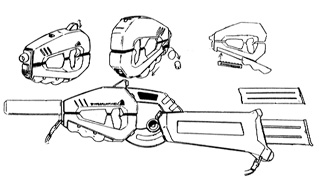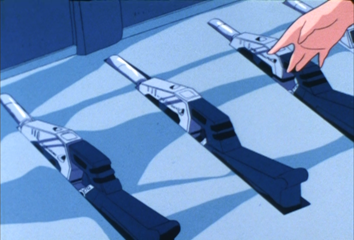

Designation:RRG - Tiresia
|

|
||||

|
|||||
 |
| A Resistance fighter on Invid-occupied Earth fires a Gallant in rifle mode with the extended barrel attachment. |
Introduced in 2030 by the REF as an all-purpose personal energy weapon, the Gallant is a versatile hand-held particle gun that has served with the REF since the time of the Opteran campaign.
In its pistol mode, the Gallant derives its energy from miniature reloadable capacitors, each of which is able to hold 4.5 kilojoules of energy—enough for three shots on an anti-personnel setting or one shot on the anti-armor setting. The extremely hot spent caps eject from the gun, and caps are fed from and stored in a removable 8-cap magazine under the forearm grip. As the pistol mode does not use protoculture, it is not visible on Invid protoculture sensors. As a safety precaution, the Gallant has a heavy trigger pull, and this leads to some muzzle climb in a single-handed pistol stance.
When a special stock with a modified flat protoculture energy cell inserted in the rear is added, the weapon becomes far more formidable. Capable of firing forty-eight 90 kilojoule shots, this weapon can pierce most light armors. The circular fixture of the rifle stock is a lighted dial that indicates what proportion of charge remains in the "flat-cell." Unlike the FAL-2's stock protoculture cell, these flat-cells can easily be recharged in the field by cutting open a standard cylindrical protoculture cell and transferring the seed containers to the flat-cell. One canister can be used to recharge ten flat-cells in this way. With the powered rifle stock in use, the weapon is easily detectable by Invid protoculture sensors.
In addition, a collimator-magnet barrel extension can be added to the weapon's nozzle. This barrel dramatically extends the effective range of the weapon and increases penetration, but drains some power from the weapon, reducing on-target energies by twelve percent. The barrel can be used in both pistol and rifle modes.
The Gallant pistol is the REF's first infantry weapon to contain an integral laser/1-5x optic sight that can interface with the Cyclone mecha's targeting computer and head-up display. It also has a limited human interface through a small flip-up eyepiece just above the handgrip.
By 2028, the REF had engaged in a number of campaigns against Tirolian space pirates, giving its troops and its weapons thorough battle trials. Although the results proved the effectiveness of both, some experiences that came out of protracted combat engagements suggested there was still room for improvement in the REF's energy weapon design.
One fundamental problem was this: During lulls in protracted battles, it is considered good battlefield practice for a soldier to swap out partly-depleted magazines in his weapons for full magazines, thus ensuring he has a fully-loaded weapon at his disposal for his next engagement. With cartridge-fed weapons, such as the AR-25 Wolverine or M-36 Badger, the soldier might then (if in a secure enough position) be able to reload partly-spent or empty magazines with fresh rounds from his field kit, or at the least consolidate the contents of two or more partly-spent magazines into fewer full magazines. However, with energy weapons such as the Owens or SAL-9, it is not possible to reload a partly-spent magazine without connecting it to a generator for several minutes—meaning that in the heat of combat, a soldier could end up with several partly-spent magazines and no full ones. (1)
Another issue was the lack of a feasible infantry energy rifle. The Wolverine and Badger were performing satisfactorily, but an intermediate design between those and heavier anti-mecha weapons was needed, especially for use with the Cyclone Veritech ride armor then in development. The FAL-2 showed promise, but the non-rechargeable protoculture cell that powered it was too costly to produce in the sort of bulk numbers necessary to supply the REF's entire infantry.
With the benefit of additional battlefield experience, Colonel Michael Owens was asked to lead the team that would design an upgraded version of his Owens energy machine pistol that would address these issues. The team soon realized that, given the breadth of the necessary changes, as well as other incremental improvements they could implement, it would be simpler to design an entirely new sidearm from the ground up. Thus began the Mars Gallant H-90 project. (Owens's design team had been in favor of calling it the "Owens II," but Owens demurred, stating that it would cause too much confusion to have two similarly-named weapons. Instead, the name "Mars Gallant" was chosen in honor of the division of the REF and the RRG research vessel in which it was designed. The name is generally shortened to "Gallant" in common usage.)
 |
| Close-up of a Gallant rifle being activated. Note the dial indicating remaining charge, and the flip-up optic sight in the active position. |
Fundamentally, the Gallant and the Owens share many common characteristics. The actual beam emitter hardware is the same, right down to having the same part numbers. From a distance, Owens and Gallant discharges appear exactly the same. The Gallant's wedge-shaped design can be considered a natural refinement of the Owens's staple-gun shape.
The first major difference between the Gallant and the Owens is that the Gallant was designed as a semi-automatic weapon from the beginning. This decreased wear on the beam emitter, and would thus extend the gun's working life. Studies had shown that soldiers tended to use the pistol form of the Owens almost exclusively in semi-automatic fire mode anyway.
Another big difference comes in the relative power levels of the shots. The Gallant design team felt that the 2 kilojoule anti-personnel blast of his first gun could be adjusted downward with only a minimal decrease in effectiveness and lethality. By decreasing their potency to 1.5 kilojoules, they could squeeze more blasts out of the same amount of energy—as well as increase the potency of the anti-armor shot by an additional half-kilojoule to 4.5 kJ by setting it equal to three times an anti-personnel shot rather than two. Allowing for eight anti-armor or 24 anti-personnel shots per magazine, the Gallant thus has 33% more anti-personnel shots than the Owens at a cost of only one fewer anti-armor shot.
The greatest and most controversial change in the Gallant was in the pistol's charge system. Where the Owens used a monolithic capacitor that held all the gun's charges in a single repository, the Gallant uses a reloadable magazine tray that contains eight disposable mini-capacitor pellets, each of which contains 4.5 kilojoules of energy. The capacitors are consumed in the process of extracting their energy, and are then ejected out a port near the gun's muzzle. (Unlike larger capacitors, these mini-caps cannot be recharged and reused, due to heat damage from the charge-extraction process.)
Critics of this system considered it a regression, bringing with it the logistical issues of ammunition management that the REF had hoped to phase out. However, thanks to the Wolverines and Badgers, the REF already had the logistical mechanisms in place to handle top-down ammunition disbursement quickly and efficiently—arguably more so than the two-way process of collecting, recharging, and redistributing Owens and SAL-9 magazines. Furthermore, the Gallant's advanced ceramic mini-capacitors were very inexpensive and easy to manufacture, and enjoyed several other advantages over ordinary cartridges as well: They were much lighter in weight, so they could be carried in greater quantities by soldiers. They had a shelf-life measured in years, theoretically even decades, with no loss of charge or deterioration. They were also far less vulnerable to accidental discharge due to impact or fire—and if they were accidentally discharged, they would simply ground out or explode in place instead of sending a bullet in a random direction. Finally, they would render the Gallant pistol fully combat-reloadable, so that soldiers would no longer be left with the problem of half-discharged magazines.
But creating a better pistol was not the only goal before the Gallant design team. Considering the need for a compact energy rifle for the REF's infantry, the Gallant would improve upon the FAL-2's multi-magazine adaptability by creating a protoculture-powered rifle stock that could interface with the Gallant pistol to increase its effective blast power. The economical problem that had kept the FAL-2 from seeing wide adoption was solved by making it possible to reload the Gallant rifle stock's protoculture cell in the field. The Gallant in its rifle configuration is capable of delivering up to 48 90kJ blasts in semi-automatic mode only; in consideration of the powerful nature of its anti-armor blast, burst fire was deemed unnecessary.
At the same time the Gallant was being developed, other divisions of the Robotech Research Group were in the process of perfecting the Cyclone Veritech ride armor. The specs for the Cyclone's targeting computer had been made available to the Gallant team; thus, it was a simple matter to integrate a laser and optical sighting mechanism into the Gallant design that would interface with it. This would allow a Cyclone operator to fire the Gallant as effectively as one of the Cyclone's onboard weapon systems. (Picatinny-mounted versions of this mechanism were later provided for use with the Owens gun, Wolverine, and Badger, though by this time the Gallant had been so exclusively adopted by Cyclone troops that there was rarely any need for their use.)
 |
| A case of first-production-run Gallant rifles, as provided to the Marcus Antonius's fleet. |
When the Gallant prototype was completed in late 2029, the REF leadership was duly impressed and immediately ordered a full production run. At this time, the REF was preparing to send the Marcus Antonius's relief fleet to Earth to help fight the Robotech Masters; judging their need to be the most pressing, the Gallant's first production run was almost exclusively issued to troops in this fleet. This first production run is considered the most sought-after version of the Gallant, both for collector value and for usability due to the cost-cutting measures that followed.
Between the first and second production runs, the molding of the composite casing was changed, ostensibly to further ruggedize the gun while reducing manufacturing costs. However, this also had the effect of making the gun seem less sturdy; some officers complained that it felt like they were holding a toy instead of a real gun. However, exhaustive testing showed that this was strictly an ergonomic issue and the gun's actual function and sturdiness were unimpeded; thus, the changes stayed and grumbling gradually ceased as the soldiers got used to them.
However, this was not the only expression of discontent associated with the Gallant, nor was it the loudest. Although infantry soldiers were by and large happy with this new weapon, seeing it as a worthy replacement for the Wolverine, officers who were accustomed to carrying Owens's first pistol design were less sanguine. Some of them preferred the greater stopping power of the 2.0kJ shot as opposed to the Gallant's 1.5kJ; others, such as Colonel Jonathan Wolff, were mecha pilots who preferred being able to charge up from their vehicles' onboard power supply over being dependant on external ammunition. Many otherwise-undecided officers simply preferred the aesthetics of the Owens, to which they had become accustomed over the years.
Since the overall effectiveness of the pistol version of both guns was about the same, and they used many identical parts in their maintenance, the REF acceded to Wolff's request that officers be allowed to choose either an Owens or a Gallant pistol as their personal sidearm. Infantry soldiers, who were issued the Gallant rifle kit, were not given that choice. Over time, as new officers were commissioned and old ones retired or (as in Wolff's case) were sent to Earth, the proportion of Owens-using officers decreased; by 2042, almost 90% of all REF commissioned officers chose to carry the Gallant.
Although it was never manufactured on Earth, the Gallant was one of the most commonly-used energy pistols by the anti-Invid Resistance, simply because it was so readily available. (The rifle mode of the Gallant was used less often, for fear of attracting the Invid.) Thousands of Gallants arrived with the early Pioneer returns to fight the Robotech Masters, and thousands more arrived with the doomed 10th and 21st Mars Division deployments. Every wrecked Horizon-T transport shuttle would yield enough guns and capacitor pellets to keep a number of Resistance cells well-supplied, and the Gallant did have the advantage over the Owens that it could be reloaded without needing electricity. Many of these weapons are still in civilian hands.
(1) The universal recharging kit supplied with Owens and SAL-9 pistols did allow consolidating the contents of two partly-spent magazines into one; however, the procedure was considered too complex for ordinary battlefield use, and it did not solve the problem of recharging spent magazines—or of the FAL-2's protoculture stock cell, which could not be replenished at all.
Go to REF Armor/Weapons Index.
Go to the Robotech Reference Guide Home Page.